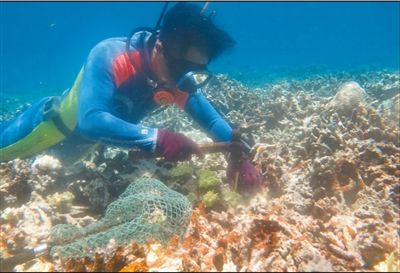

Taking a scientific approach to repairing corals is extremely important to the maintenance of the marine environment and coastal safety. Researchers in the sea area west of Fenghuang Island in Sanya city, south China's Hainan province, have committed themselves to doing exactly that, by ”planting" corals on the seafloor.

(Photo courtesy of Hainan South China Sea Institute of Tropical Ocean)
On an offshore test platform, Chen Hong, director of the Hainan South China Sea Institute of Tropical Ocean, leads a research team to break down collected corals into small pieces and tie them to a seedbed.
These coral seedlings will later be planted in the sea. The team conducts experiments during the day and studies the results at night. Their goal is to build a beautiful coral bed at the bottom of the sea and cultivate millions of corals.
Today in the sea area west of Fenghuang Island, there are patches of coral floating. But 10 years ago, it was a different story: there were only a small number of coral reefs in these waters, and living corals were even rarer.
On June 8, 2011, the Fenghuang Island coral reef ecological restoration project officially began. On that day, with the support of the former Sanya marine and fishery bureau, the research team from Hainan South China Sea Institute of Tropical Ocean tentatively dropped an artificial coral reef weighing about 250 kg attached to the stony coral seedlings cultivated that year on the west side of Fenghuang Island.
When some corals were destroyed by typhoons in 2016, the institute used asexual reproduction to re-cultivate 40,000 coral seedlings, forming 1,500 square meters of an embryonic form of coral reef.
In early 2017, the research team compiled statistics on the growth of the tested corals and discovered that the survival rate of the corals planted in 2016 was more than 95 percent, proving that initial progress had been made. In 2017, another 101,300 coral seedlings were cultivated in the waters of Fenghuang Island, where the institute is located.
Later, during the ecological restoration of coral reefs, according to the chain relationship of the ecosystem, the research team also cultivated symbiotic species closely related to corals, such as shellfish, which improve water quality, and macroalgae, which reduce water eutrophication and improve species diversity, so as to improve the coral reef ecosystem.
"The future coral garden will be an integrated ecosystem featuring a trinity of tourism, environmental protection and scientific research," said Chen Hong, adding that the research team hopes that the planted undersea corals can add a touch of bright color to the ocean world.
 Fire brigade in Shanghai holds group wedding
Fire brigade in Shanghai holds group wedding Tourists enjoy ice sculptures in Datan Town, north China
Tourists enjoy ice sculptures in Datan Town, north China Sunset scenery of Dayan Pagoda in Xi'an
Sunset scenery of Dayan Pagoda in Xi'an Tourists have fun at scenic spot in Nanlong Town, NW China
Tourists have fun at scenic spot in Nanlong Town, NW China Harbin attracts tourists by making best use of ice in winter
Harbin attracts tourists by making best use of ice in winter In pics: FIS Alpine Ski Women's World Cup Slalom
In pics: FIS Alpine Ski Women's World Cup Slalom Black-necked cranes rest at reservoir in Lhunzhub County, Lhasa
Black-necked cranes rest at reservoir in Lhunzhub County, Lhasa China's FAST telescope will be available to foreign scientists in April
China's FAST telescope will be available to foreign scientists in April "She power" plays indispensable role in poverty alleviation
"She power" plays indispensable role in poverty alleviation Top 10 world news events of People's Daily in 2020
Top 10 world news events of People's Daily in 2020 Top 10 China news events of People's Daily in 2020
Top 10 China news events of People's Daily in 2020 Top 10 media buzzwords of 2020
Top 10 media buzzwords of 2020 Year-ender:10 major tourism stories of 2020
Year-ender:10 major tourism stories of 2020 No interference in Venezuelan issues
No interference in Venezuelan issues
 Biz prepares for trade spat
Biz prepares for trade spat
 Broadcasting Continent
Broadcasting Continent Australia wins Chinese CEOs as US loses
Australia wins Chinese CEOs as US loses